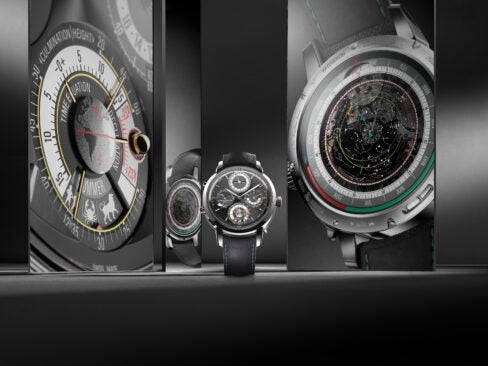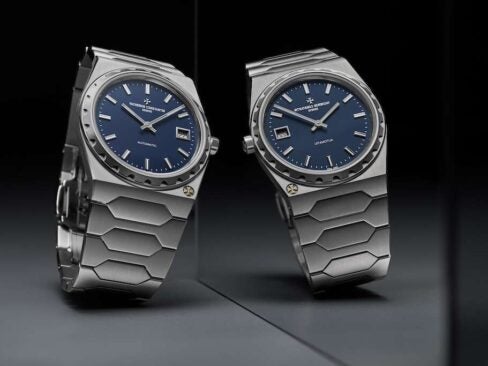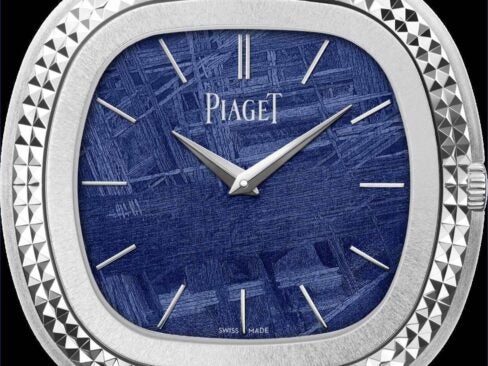The 14th Edition of the Grand Prix D’Horlogerie de Geneve is under way, and this year no less than 72 pre selected watches will be running to win the “Aiguille d’Or” Grand Prix.
With this year’s GPHG attracting record participation, all major watch groups are being represented, along with a number of independent companies.
Vote for your favorite amongst the following pre-selected watches and automatically participate in the drawing to win a Girard – Perregaux Vintage 1945 XXL Petite Seconde, worth $11372.29.
Here are the six finalists in the Tourbillon category. Tomorrow we will be revealing the Calender category.
 BLANCPAIN, 12-DAY ONE-MINUTE FLYING TOURBILLON
BLANCPAIN, 12-DAY ONE-MINUTE FLYING TOURBILLON
Blancpain values are based on a process of perpetual renewal by pushing the boundaries of watchmaking and constantly improving horological complications. Two centuries after the invention of the tourbillon and 25 years after the creation of Calibre 23, the world’s first and thinnest hand-wound flying tourbillon, Blancpain reinterprets and further refines this complication designed to break free of the effects of gravity and currently representing one of the masterpieces of traditional horology.
Developed in the watchmaking workshops of the Manufacture, as indeed are all Blancpain movements, the new Calibre 242 takes things to a new level by further improving on the record- breaking autonomy of Calibre 25 unveiled in 1998: the world’s first self-winding tourbillon with an 8-day power reserve. The new self-winding tourbillon movement has an exceptional 12-day power reserve guaranteed by a single barrel. Comprising 243 parts united within just a space just 6.10 mm thick and 30.60 mm in diameter, it is is equipped with a silicon balance- spring and pallet-fork horns in order to alleviate the effects of magnetic fields.
For this new model, Blancpain has applied its technical expertise to serving aesthetic elegance. Each detail of the movement has been designed to highlight the decoration visible through the sapphire crystal. The automatic winding mechanism and the power reserve have been integrated so as to create a thin movement. The oscillating weight has also been entirely openworked and the “kerbs” have been eliminated so as to provide a broader space for decoration. The bridges and power-reserve disc are entirely decorated with a hand-guilloché motif – an ancestral skill calling for meticulous and accurate execution; while the ratchet-wheel features a bevelled wheel-rim design.
On the dial side, the off-set tourbillon carriage at 12 o’clock has been enlarged to offer a perfect view of the new design of the balance and the escape-wheel. This being a flying tourbillon, the carriage has no upper bridge and thus provides an unobstructed view of this complex mechanism. It rotates once a minute in order to compensate for the effects of gravity. Reflecting the Villeret collection identity, the dial and the painted Roman numerals are in grand feu enamel, gracefully swept over by hollowed sage leaf-shaped hands.
This timepiece with its double stepped 42 mm case is available in a limited numbered platinum edition. It also comes in 18K red gold teamed with a chocolate brown alligator strap lined with alzavel calfskin and secured by a triple-blade folding clasp.
 BREGUET, CLASSIQUE TOURBILLON EXTRA-PLAT AUTOMATIQUE
BREGUET, CLASSIQUE TOURBILLON EXTRA-PLAT AUTOMATIQUE
Previewed at Baselworld 2013, Breguet’s Classique Tourbillon extra-plat automatique returns to the stage nobly dressed in platinum. Its looks are matched by ingenuity, for this extra-thin watch houses one of the more spectacular horological inventions – an off-centred tourbillon of which the lightened titanium carriage carries a Breguet balance with a silicon balance spring, as well as a specially developed escapement.
These technical features notably enable the balance of the calibre 581DR movement powering this Classique Grande Complication to reach the frequency of 4Hz, which is high for a tourbillon balance. This does not imply any loss of power reserve, for the patented high-energy barrel keeps the reference 5377 going for up to 80 hours off the wrist. To keep the thickness of the movement down to 3 mm in a 7 mm-high case, Breguet designed a peripheral rotor in platinum, winding in both directions of spin. This technical achievement makes the reference 5377 the thinnest self-winding tourbillon currently on the market.
The stylistic features of the dial of this 42 mm platinum wristwatch include four different engine-turned patterns executed by hand as a mark of respect for the old traditions of supreme workmanship and flawless finish. The hours and minutes chapter is enhanced by a clou de Paris hobnail pattern edged by a barleycorn motif. The power-reserve indicator at 8:30 is decorated with engine-turned strait chevrons, while each element has a cross-hatched border. A blue sapphire set into the centre of the tourbillon bridge draws the eye to the hands. This new self-winding extra-thin Classique Grande Complication Tourbillon shows off its class as a pure Breguet creation, combining timeless styling and cutting-edge technology.
 BULGARI, OCTO FINISSIMO TOURBILLON
BULGARI, OCTO FINISSIMO TOURBILLON
The quest for thinness has been one of the watchmaker’s goals for a long time. By introducing the Octo Finissimo Tourbillon, Bvlgari has reached a new milestone in the development of ultra-thin watches with a major complication: its 1.95-mm-thick movement makes this flying tourbillon simply the slimmest on the market – no others even come close – and the thinnest ever made. This house movement is thinner than a Swiss five-franc coin, and right from the start, its design had to incorporate several solutions to reduce the overall thickness. The starting point was the tourbillon cage, a decisive factor in the construction process. It is 1.95 mm thick, a fact that shaped the rest of the structure. Once incorporated into the plate, the cage determined the thickness of the entire movement. The overall architecture also includes two bridges, one for the minute wheel and the other for the gear train of the tourbillon cage, which rotates once a minute.When all is said and done, everything about the Finissimo Tourbillon calibre speaks of mechanical innovation. It has 249 components and its finishes are completely in keeping with its exceptional nature, down to the last detail: the plate and bridges are bevelled and decorated with Côtes de Genève, the gears are bevelled and circular satin-brushed, screw heads and slots are bevelled and the ends are polished. The calibre, which displays the hours and minutes on a black dial, is lacquered and polished with great simplicity, and fits within a platinum case 40 mm in diameter, which extends into a black alligator strap with a platinum buckle. Without exaggerating the achievement, the Octo Finissimo Tourbillon represents a big step forward in the ongoing quest for thin watch complications.
 GRÖNEFELD, PARALLAX TOURBILLON
GRÖNEFELD, PARALLAX TOURBILLON
The Parallax Tourbillon features: a flying tourbillon; tourbillon cage synchronised to large central seconds hand (with innovative mechanism to improve accuracy); push-to-set-push-to-wind crown; crown function indicator; hacking seconds; power reserve indicator; all stainless steel bridges; in-house movement; superlative hand finishing; multi-layered solid silver dial.
The Grönefeld Parallax Tourbillon features a “flying” tourbillon with a large central seconds hand, stop seconds, a power reserve- and winding-setting mechanism indicator.
The in-house movement displays sophistication and craftsmanship at the very highest level.
Well-designed and impeccably executed tourbillons are particularly accurate timekeepers.
The flying tourbillon allows full appreciation of the concentric, rhythmic “breathing” of the balance hairspring, while ensuring high precision.
Bart and Tim Grönefeld further highlighted the tourbillon by raising it out of the movement and above the dial.
As with the immaculately finished movement bridges, the tourbillon cage is crafted in stainless steel. Three days are required just for the hand finishing of the tourbillon components.
 MONTBLANC, VILLERET EXOTOURBILLON RATTRAPANTE
MONTBLANC, VILLERET EXOTOURBILLON RATTRAPANTE
With the ExoTourbillon Rattrapante from the Collection Villeret 1858, Montblanc presents a unique timepiece in the world of haute horlogerie. This wristwatch combines a split-second chronograph and Montblanc’s patented ExoTourbillon, which has a large balance that oscillates outside the tourbillon’s rotating cage. The three-dimensional regulator dial is made of gold, decorated with grand feu enamel elements crafted in accord with the tradition of ultrafine watchmaking, and includes a display for a second time zone with a day/night indicator.
The Montblanc Manufacture in Villeret has acquired comprehensive expertise in the discipline of grandes complications. The manufactory’s history began in 1858, when it was established under the name “Minerva”. The manufactory is one of the few which doesn’t only fabricate components: ever since its earliest days, complete and meticulously handcrafted movements have been developed and built here. Their ongoing development and the broad know-how in the discipline of measuring brief intervals led to the production of split-second stopwatches in the mid 1930s. So-called rattrapante chronographs can measure intermediate times without interrupting the ongoing measurement of a longer elapsing interval. These stopwatches from the manufacture in Villeret were used successfully at the Winter Olympics in 1936.
Today too, the Montblanc Manufacture unites traditional Swiss horological craftsmanship of the highest level and an indefatigable striving for innovation.
 TAG HEUER, CARRERA MIKROPENDULUM TOURBILLON
TAG HEUER, CARRERA MIKROPENDULUM TOURBILLON
Over the last decade, tag heuer’s avant-garde haute horlogerie workshop has pulled off some of the most impressive breakthroughs in watchmaking history.
The core of that achievement is its high-precision mikro series, a platform of powerful technological innovations that sweep away many of watchmaking’s centuries-old traditional approaches. this results in the production of a chronograph collection accurate to 1/100th of a second and even more.
The haute horlogerie atelier’s recent breakthroughs include the carrera pendulum (2010), the first escapement to work with magnets instead of a traditional hairspring, the carrera mikrograph (2011), the first wrist mechanical chronograph to master 1/100th of a second on the central hand, and the carrera mikrotourbillons (2012), the fastest and most accurate double tourbillon.
In 2014, tag heuer takes another step beyond with the carrera mikropendulum tourbillon – the world’s first double tourbillon combining a mechanical tourbillon for the watch and a magnetic tourbillon regulation system for the chronograph, accurate to 1/100th of a second.











